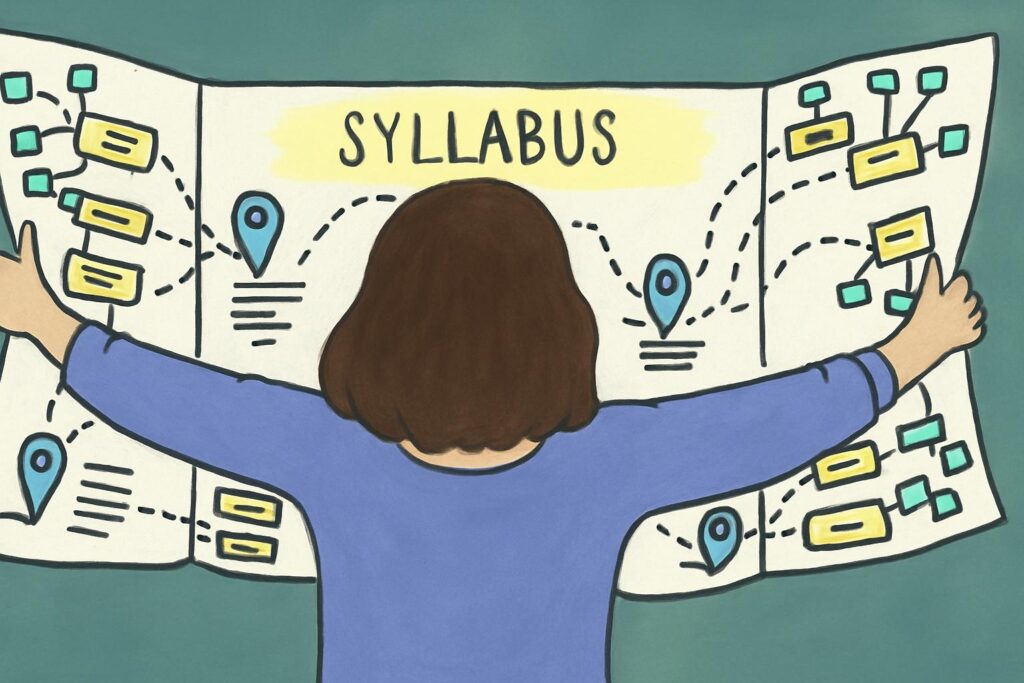By Marion J. Tate, Ph.D. CETL, Assistant Director of Educational Development

Ask any professor to list their favorite or most powerful teaching tools, and you will likely hear a list that includes classroom discussions, assignments, technology, or assessments. The syllabus, as a teaching tool, is rarely on the list (e.g., Bano et al., 2019). This compulsory yet humble document does more than outline dates, policies, and assignments; it sets the tone for the entire learning experience. The syllabus is the first introduction between professor and student, the first clue about what kind of journey lies ahead.
When treated as a living, pedagogically rich document for teaching, the syllabus can effectively communicate its purpose and serve as a document that inspires students. It invites students to learn in a vibrant, intentionally engaging, and meaningful environment, rather than functioning as a dry, mechanical form of institutional compliance. A thoughtfully designed syllabus can spark curiosity, build trust, and cultivate a more dynamic and collaborative classroom experience. So why does it often get overlooked? Possible reasons include a lack of time, limited design training, or inconsistent practices. What might be possible if you devoted adequate time and care to syllabus development? Consider the following six tips to enhance your syllabus design:
Tip 1: Throughout your syllabus, reflect your teaching philosophy and instructional design (Odivilas, 2015) to communicate your approach to teaching.
- Show alignment between learning outcomes, activities, and assessments (e.g., through a course flowchart or visual organizer).
- Include a learning rationale for major assignments (e.g., “This assignment invites you to apply critical theory to real-world events, building transferable analytical skills”).
- Use scaffolded assignments that demonstrate intentional sequencing (e.g., assignments that are built on one another and increase in complexity over time).
Tip 2: Communicate the purpose of assignments and activities to ensure that students understand the rationale.
- State how course outcomes connect to broader life, career, or community goals.
- Use a sidebar or callout to explain why readings were selected.
- Begin the syllabus with a course narrative (e.g., “In the course we’ll uncover how stories shape identity, challenge power, and create empathy”).
Tip 3: Convey enthusiasm for the subject to help inspire learners.
- Write a brief paragraph explaining why the course matters and what you hope learners will gain.
- Add a quotation or anecdote related to the field or course theme (e.g., quotes from Bell Hooks or Einstein).
- Frame the course as a shared journey or intellectual adventure, not just a list of requirements.
Tip 4: Design the syllabus to show learners as active participants in learning, inviting them to a vibrant, intentionally engaging, and meaningful learning environment.
- List student-centered activities like peer teaching, experiential projects, fieldwork, or digital storytelling.
- Add flexible learning options, such as choice boards or alternative assignments.
- Show how students’ backgrounds and voices shape the course, such as through journals or cultural discussions.
Tip 5: Invite questions and exploration to spark learners’ curiosity.
- Title weekly modules with provocative questions (e.g., “Can language shape reality?” instead of “Week 2: Linguistics”).
- Add “mystery” days or surprise guest speakers.
- Include a section on “Questions We’ll Wrestle With.”
Tip 6: Communicate that you are a partner in the learning process (Katsampoxaki-Hodgetts, 2022) to build trust.
- Offer a clear policy on late work framed around compassion and communication.
- Include a “What to do if you’re struggling” section with campus resources and personal encouragement.
- Use inviting, inclusive language (e.g., “You’re encouraged to…” rather than “You must…”).
A carefully constructed syllabus can be more than a contract or schedule. It can be an effective tool for teaching and connecting with students. The syllabus has the potential to reflect your instructional values, communicate your enthusiasm for the subject, and demonstrate to students that learning is a collaborative, active process. When students see themselves as participants rather than passive recipients, they are more likely to engage with curiosity and purpose. By clearly explaining the rationale behind course activities and assignments, the syllabus helps students understand how each component supports their growth. Of central importance, it signals that you are a partner in their learning journey, supporting, challenging, and learning alongside them.
References
Bano, A., Ali, M., & John, S. (2019). Issues of syllabus designing practices and quality assurance at higher education level. Global Social Sciences Review (GSSR), 4(4), 135-145.
Katsampoxaki-Hodgetts, K. (2023). The ‘naked’ syllabus as a model of faculty development: Is this the missing link in Higher Education?. International Journal for Academic Development, 28(4), 451-467. https://doi.org/10.1080/1360144X.2022.2025814
Odivilas, H. A. (2015). Syllabi preparation and utilization in college teaching. European Scientific Journal, 11(7), 483–503.